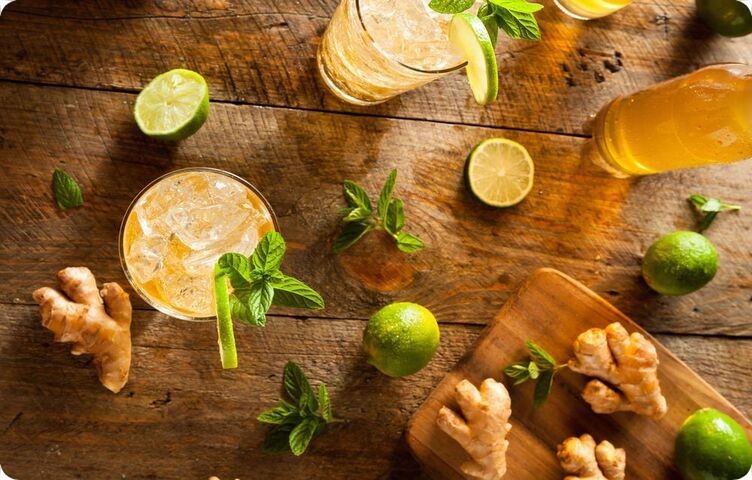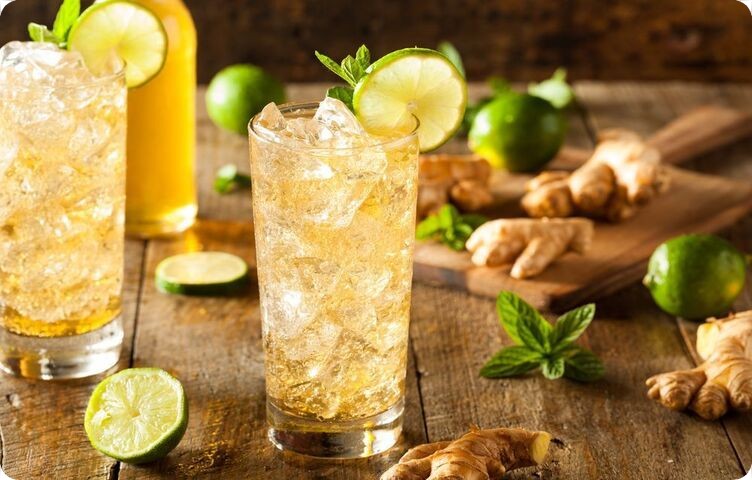The spicy flavor of ginger ale pairs with a variety of foods, from spirits to tropical fruits. Thanks to this, the aromatic non-alcoholic drink is included in more than 20 cocktails. Not only is it delicious, but it is also good for heart and digestive health. Let's get acquainted with the unusual history of this popular drink!
History of appearance
There are two main types of ginger ale - golden and dry . The first variant, called dark or golden, was created in Ireland in 1851. It was prepared from ginger extract, sugar and water. The mixture did not contain alcohol, and was a sweet “pop” that was carbonated with carbon dioxide. It gained wide popularity in the UK, and later in Canada and the USA. Golden Ale has a distinct ginger flavor and deep golden color.
In 1890, a new variety of product appeared - dry. His recipe was compiled by John McLaughlin, a Canadian pharmacist and owner of a soda factory.
The production of the drink consisted of five steps:
- preparation of ginger root - the raw material is cleaned and crushed;
- soaking - the ginger mass is soaked in hot water to release aromatic compounds;
- adding sweeteners;
- carbonation - achieved by carbonation through natural fermentation or the addition of carbon dioxide;
- adding flavorings and preservatives.

McLaughlin developed a mass bottling technology that helped him successfully sell the drink. The bottle labels featured a map of Canada and the country's national mascot, the beaver.
McLaughlin later refined the recipe, resulting in a dry ale with a softer taste and lighter color. The resulting product was patented under the brand name Canada Dry Pale.
This type of ale has become an excellent alternative to soda water. It gained the greatest popularity during the Prohibition era in the United States. Illegal bars were forced to create alcoholic cocktails based on moonshine. The spicy aroma of ginger ale helped mask the unpleasant smell of homemade alcohol. In the 21st century, a third type of product appeared - dietary. It won't hold back any sugar or corn syrup. Sweet taste is created by sweeteners.
There is also a variety made from kombucha - kombucha. It is produced from a culture enriched with probiotics. This fermented drink contains ground or fresh ginger root; no chemical flavors or flavor enhancers are added.
Composition and properties of ginger ale
The product belongs to the category of highly carbonated soft drinks. Original varieties are prepared from fresh ginger root, sugar, fermented water . An important ingredient is microbial cultures - yeast or so-called “ginger bugs” (fermented mass of sugar and ginger). Sugar or corn syrup gives the drink its sweet taste; diet versions contain artificial sweeteners.
Manufacturers of the best varieties use fermented ginger root containing lactobacilli and wild yeast to make gingerbug. But in commercial products, the natural root is often replaced with artificial ginger flavoring. Alkaline compounds, including sodium bicarbonate, are added to neutralize acidity. The drink may also contain dyes and preservatives - citric acid, sodium benzoate .
Although ale contains sugar, its calorie content is lower than that of regular beer or Coca-Cola - 34 kcal per 100 grams. However, this amount of calories represents 7% of the daily diet of an adult.
The product contains no caffeine, protein or fat . The volume of carbohydrates does not exceed 9 g per 100 g. The same amount of product contains 7 mg of sodium and 1 mg of potassium.
What are the benefits of ginger ale?

Traditional varieties of the drink, prepared on the basis of natural ginger, have probiotic properties, having a beneficial effect on the intestinal microflora and immunity. The beneficial properties of ale are explained by the content of bioactive substances that are part of ginger - gingerols and shogaolams. These compounds have powerful anti-inflammatory effects. .
Ginger ale has ten types of beneficial effects on the body:
- stops nausea - stops cramps and vomiting due to stomach upsets;
- reduces symptoms of toxicosis - drinking ginger ale in the morning helps fight nausea during pregnancy;
- improves digestion - gingerols includedginger improves gastric peristalsis, allowing food to be digested faster;
- eliminates flatulence - probiotics formed during fermentation of the drink improve intestinal microflora, as a result of which bloating and the formation of gases stop;
- reduces sore throat - ginger essential oils destroy pathogenic microbes, relieving swelling and pain during colds and sore throats;
- relieves migraines - ginger ale suppresses the production of neurotransmitters that cause headaches, relieves spasms, dilates blood vessels in the brain;
- replenishes fluid loss - the product quickly restores the water-salt balance after vomiting, diarrhea, severe sweating during a cold;
- reduces menstrual pain - the high level of antioxidants in ginger root and the antispasmodic properties of its essential oils help relax the uterus and relieve pain;
- relieves hangovers - quickly replenishing the water-salt balance, ginger ale helps cope with nausea and headaches;
- makes it easier to undergo chemotherapy - the antiemetic properties of ginger help fight the side effects of anti-cancer medications.
Only a drink made from natural ginger has beneficial properties. Ale containing artificial flavors, colors and corn syrup is just plain lemonade.
It is important to remember that even a high-quality product can be used in moderation in the diet. Excessive consumption of soda causes bloating, diarrhea, and leads to the formation of gallstones. Since the product contains a lot of sugar, it can cause obesity and predisposition to diabetes. For people who take blood thinning medications, ginger ale is contraindicated.
















































/https%3A%2F%2Fcomplexbar.com%2Fimages%2Fblog%2F244%2Fimbirnogo-elya.jpg)
/https%3A%2F%2Fcomplexbar.com%2Fimages%2Fblog%2F246%2Fsirop_scale_2400.jpeg)
/https%3A%2F%2Fcomplexbar.com%2Fimages%2Fblog%2F246%2Fkofe-vostochniy.jpg)
/https%3A%2F%2Fcomplexbar.com%2Fimages%2Fblog%2F245%2Fpexels-jason-villanueva-851555.jpg)
/https%3A%2F%2Fcomplexbar.com%2Fimages%2Fblog%2F246%2F2024-04-09_17.22.54.jpg)
/https%3A%2F%2Fcomplexbar.com%2Fimages%2Fblog%2F246%2F2024-04-09_17.22.47.jpg)
/https%3A%2F%2Fcomplexbar.com%2Fimages%2Fblog%2F246%2FCODE_anons_foamydrops_752%D1%85480_eng.jpg)
/https%3A%2F%2Fcomplexbar.com%2Fimages%2Fblog%2F246%2FAlina_752%D1%85480_eng.jpg)
/https%3A%2F%2Fcomplexbar.com%2Fimages%2Fblog%2F246%2F2024-04-09_17.23.22.jpg)
/https%3A%2F%2Fcomplexbar.com%2Fimages%2Fblog%2F246%2F2024-04-09_17.23.28.jpg)
/https%3A%2F%2Fcomplexbar.com%2Fimages%2Fblog%2F246%2F2024-04-09_17.23.35.jpg)
/https%3A%2F%2Fcomplexbar.com%2Fimages%2Fblog%2F246%2Fdrinksome_752%D1%85480_eng.jpg)
/https%3A%2F%2Fcomplexbar.com%2Fimages%2Fblog%2F246%2Fnude_752%D1%85480_eng.jpg)
/https%3A%2F%2Fcomplexbar.com%2Fimages%2Fblog%2F246%2F752%D1%85480_eng__1_.jpg)
/https%3A%2F%2Fcomplexbar.com%2Fimages%2Fblog%2F246%2F752%D1%85480_eng.jpg)
/https%3A%2F%2Fcomplexbar.com%2Fimages%2Fblog%2F246%2FStudioRaw_752%D1%85480_eng.jpg)
/https%3A%2F%2Fcomplexbar.com%2Fimages%2Fblog%2F246%2FDoppio_tea_752%D1%85480_eng.jpg)
/https%3A%2F%2Fcomplexbar.com%2Fimages%2Fblog%2F246%2FTognana_Stars_Stripes_752%D1%85480_eng.jpg)
/https%3A%2F%2Fcomplexbar.com%2Fimages%2Fblog%2F246%2FRona_752%D1%85480_eng.jpg)
/https%3A%2F%2Fcomplexbar.com%2Fimages%2Fblog%2F246%2FDoppio_vending_752%D1%85480_eng.jpg)
/https%3A%2F%2Fcomplexbar.com%2Fimages%2Fblog%2F246%2FEssence_sukhie_smesi_752%D1%85480_eng.jpg)
/https%3A%2F%2Fcomplexbar.com%2Fimages%2Fblog%2F246%2FODK_sukhie_smesi752%D1%85480_eng.jpg)
/https%3A%2F%2Fcomplexbar.com%2Fimages%2Fblog%2F246%2Funiforma-barmena.jpg)
/https%3A%2F%2Fcomplexbar.com%2Fimages%2Fblog%2F246%2Fkak-nanyat-barmena.jpg)
/https%3A%2F%2Fcomplexbar.com%2Fimages%2Fblog%2F246%2Fsirop_scale_2400.jpeg)
/https%3A%2F%2Fcomplexbar.com%2Fimages%2Fblog%2F246%2FPeugeot_Anons_Paris_U%27Select_Line_Daman_752%D1%85480_eng.jpg)
/https%3A%2F%2Fcomplexbar.com%2Fimages%2Fblog%2F246%2Fkofe-vostochniy.jpg)
/https%3A%2F%2Fcomplexbar.com%2Fimages%2Fblog%2F246%2FMadler.jpg)
/https%3A%2F%2Fcomplexbar.com%2Fimages%2Fblog%2F246%2Fprofbartender_glavn.jpeg)